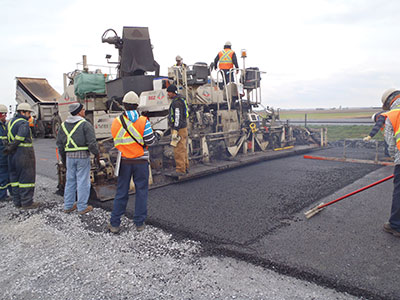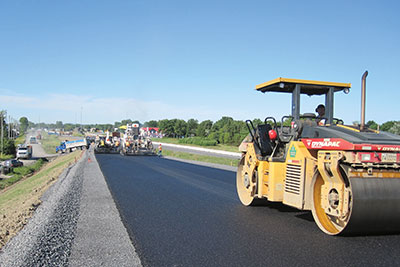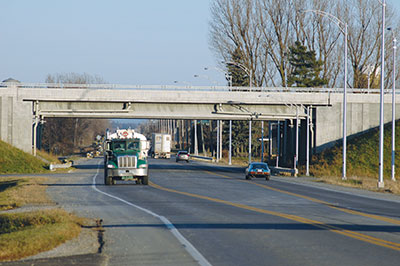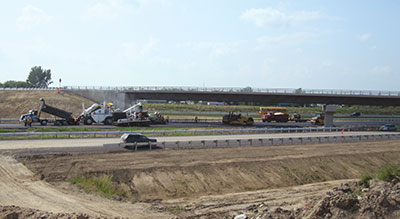
Features
Projects
Roads & Paving
A-35 Inches Southward
Construction resumes on missing leg of Montreal-to-Boston corridor.
July 25, 2013 By Carroll McCormick
It will have taken exactly 50 years, but in 2017 the missing
37.9-kilometre link of a 500-kilometre, limited-access highway between
Montreal and Boston will, if all stays on scheme and schedule, open for
traffic.
It will have taken exactly 50 years, but in 2017 the missing 37.9-kilometre link of a 500-kilometre, limited-access highway between Montreal and Boston will, if all stays on scheme and schedule, open for traffic.

|
|
| Photo courtesy: Transports Quebec
|
Construction of the Autoroute 35 (A-35) began around 1965. It was meant to deliver northbound traffic from the U.S. onto the A-10, destination Montreal and environs, and pick up U.S.-bound traffic heading east on the A-10 and, hanging a right at Carignan, take it south to the U.S. border at Saint-Armand and onward to Boston on Vermont’s Interstate 89. Two years and roughly 19 kilometres later, the project was ditched, leaving motorists and truckers to wend their way to and from Saint-Jean-sur-Richelieu and the border on the two-lane Route 133.
In 2009 Quebec resumed construction in the form of a hoped-for seven-year project christened the Parachevèment de l’Autoroute de la Vallée-des-Forts (Completion of the Forts Valley Motorway).
The schedule has slipped a year since contractors dispatched their fleets of machines to Saint-Jean-sur-Richelieu to continue the southward push. On the bright side, by next year 3,500 vehicles a day, according to 2011 Saint-Armand border figures, will at least be able to speed along 25 fresh kilometres of blacktop while the remaining 13 kilometres are planned and laid down.
 |
|
| Laying asphalt on an exit off the A-35, in preparation for opening the first 25 kilometres of the route next year. Photos courtesy: Neilson-EBC |
The completion has been subdivided into four sections of varying lengths: Segment 1 at 9.8 kilometres and Segment 2 at 14.7 kilometres are being built first, and in rough lockstep. Segment 3 at 8.9 kilometres and Segment 4 at 4.5 kilometres will be built last. To date a firm construction timetable is not available.
The project includes five interchanges. Huge culverts are being assembled over streams that will flow under the A-35 and bridges will cross numerous small watercourses. The longest bridge will be a 225-metre, three-span bridge with a concrete slab roadbed on steel beams, over the Rivière aux Brochets, which drains into Lake Champlain.
Preparation for the roadwork has included shifting the routes of services such as power lines, gas and water mains and communication company installations. The Ministry of Transport already owned the land for the original route of the A-35, but had to purchase another 200 acres to accommodate adjustments in the final route plan. More land purchases are underway for the Saint-Alexandre interchange in Segment 2 and for unspecified amounts of additional land required for Segments 3 and 4.
Transports Quebec awarded the contracts for Segments 1 and 2 to four major Quebec companies and consortiums, for work ranging from excavation to building complex structures: a consortium of Saint-Nicolas-based Neilson and L’Ancienne-Lorette-based EBC; Brossard-based L.A. Hébert; a consortium of Saint-Bruno-de-Montarville-based Bricon and Delson-based Construction Caron; and Boucherville-based DJL. Transports Quebec awarded almost 20 other contracts to specialized contractors.
The cost of the full project is currently calculated at $460 million in 2010 dollars. It is being built under a conventional public model; i.e., not under a public-private partnership, as was the case for the privately operated western section of the recently completed A-30 Montreal ring road. The Canada Strategic Infrastructure Fund supplied $44 million of the project cost and the Border Infrastructure Fund supplied another $13 million.
 |
|
| The A-35 infrastructure includes this new overpass over Route 133 in Saint-Alexandre. Photo courtesy: Transports Quebec
|
Construction began in January 2009 on section 2, which is located between a point just north of Route 227 and Route 133 to the south. The Neilson-EBC consortium got two section 2 contracts, one of which, for example, was to complete 12.7 kilometres of Segment 2 between Route 222 and Route 133. Work that year and in 2010 included laying down the roadway foundations, deforestation, reconstruction of agricultural drainage, excavation, drainage and construction of concrete culverts.
Construction of the Saint-Sébastien interchange at Route 133 began in the fall of 2010, and to date, two of the five interchanges, the other being the Iberville interchange at the top of section 1, are completed.
From January to mid-March 2010 contractors deforested the route for Segment 1. In September 2010, L.A. Hébert began work on seven kilometres of Segment 1 between Saint-Jean-sur-Richelieu and Saint-Alexandre.
Work the following year on Segment 1 included rebuilding agricultural drainage systems, excavation and drainage, pavement structure work, construction of concrete culverts and the installation of a plant mix base course.
In 2012 Neilson-EBC built four kilometres of Segment 1 highway, two overpasses and installed three reinforced concrete culverts. Other work begun in 2012 included laying down the plant mix surface of Segment 2 and the surface course of Segment 1.
Sections 1 and 2 were originally scheduled to open this year, but the current forecast is for them to open to traffic in 2014. DJL was scheduled to complete a contract this July and a request for tenders for one remaining contract was issued this June.
 |
|
| Much of the first 25 kilometres of the A-35 was paved in 2012. Photo courtesy: Neilson-EBC
|
Tying in Route 133 with Boulevard d’Iberville in Saint-Jean-sur-Richelieu was scheduled for 2012, but the revised schedule calls for this to be done in 2014. Also anticipated for next year, as part of completing Segments 1 and 2, is the construction of a 400-metre section of the Autoroute to Saint-Alexandre, and the connection with the Lacroix and Station streets.
Transports Quebec reports that one of the challenges that contractors have encountered is the presence of a number of zones along the length of the route that have a poor carrying capacity. Areas of particular note are the approaches to the Rivière aux Brochets and the Pike-River sector.
Transports Quebec reports the solution chosen in one such area with a poor carrying capacity: “In the Iberville interchange sector, excavated material was laid down over a period of months in order to eliminate the settling of the ground.”
Segments 3 and 4, which form the last 13.3 kilometres of the A-35, are in the pre-construction phase. Transports Quebec expects them to take three years to build. Among the structures to go up are the three remaining interchanges in Saint-Alexandre and Saint-Armand (north and south) and the bridge across the Rivière aux Brochets.
Although a completion date of 2017 is quoted in 2010 Transports Quebec documentation, the organization is currently not offering a precise completion schedule as it waits for the remaining authorizations and land acquisitions to be finalized. “There is no actual fixed schedule for the completion of Segments 3 and 4.”
Print this page